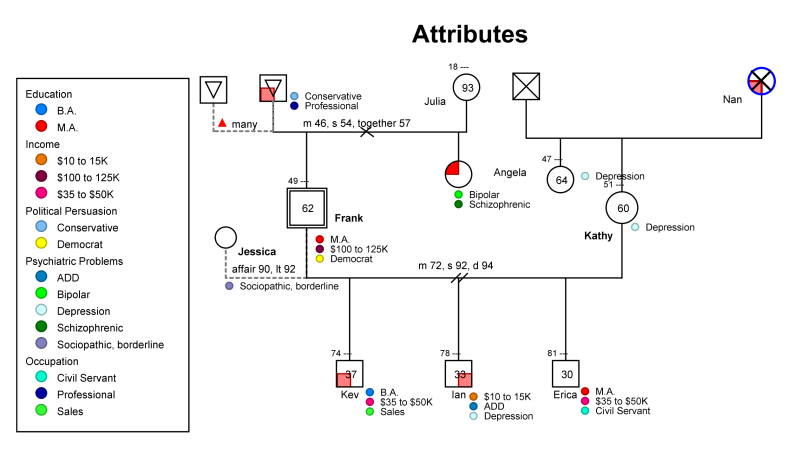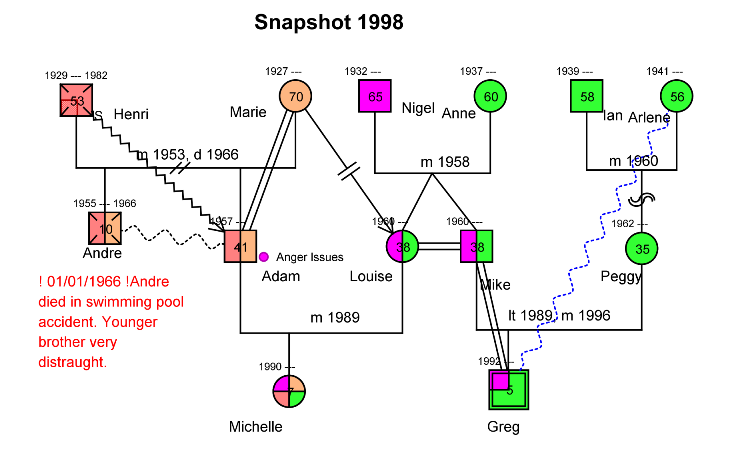What Is Bowenian Family and Couples Therapy? 5 Techniques
 Our family of origin distinctly shapes who we are.
Our family of origin distinctly shapes who we are.
From our personality and behavior to our choices in life, family plays a large role.
And this is true whether we feel close to our birth family or distant from them.
In Bowenian family systems theory, the family is seen as a complex system within which the individual is shaped. Conflict and dysfunction come from the inability of individuals to separate from their families. According to Bowen’s theory, differentiation of the self is the key to emotional independence and ultimately conflict resolution.
This article will describe how to use the concepts and techniques of Bowenian Therapy to help a family resolve conflict and aid individual family members in achieving emotional independence.
Before you continue, we thought you might like to download our three Positive CBT Exercises for free. These science-based exercises will provide you with detailed insight into Positive CBT and give you the tools to apply it in your therapy or coaching.
This Article Contains:
What Is Bowenian Family and Couples Therapy?
Murray Bowen began his work as a psychotherapist at the Menninger Clinic in 1946, studying individuals with schizophrenia (Nichols & Schwartz, 1984).
The popular theory at the time was that the relationship between mother and child played a role in the development of the illness. Although the cause of schizophrenia is still not well understood, researchers now believe it is a combination of genetic, biological, and environmental factors (DeLisi, 2021).
In his work with mothers and children, Bowen began to develop his theory of differentiation of self, which would become a cornerstone of his family systems theory.
Differentiation is defined as autonomy, the ability to interact with others without getting enmeshed. An individual who has differentiation will be able to have a strong sense of self that is not dependent on the opinion of others. They can make decisions without being overly swayed by emotions.
Conversely, an individual who has a poorly differentiated sense of self overly depends on the opinions of others. They have a chameleon-like ability to conform and change based on the acceptance of others.
Bowen recognized that the family system may either promote independence and differentiation or create an environment of enmeshment, where independence is thwarted. One of the main goals of Bowenian Therapy is to help foster self-differentiation.
6 Concepts of Bowenian Therapy

- Differentiation of self
- Triangulation/triangles
- Emotional cutoff
And three main processes:
- Family projection process
- Multi-generational transmission process
- Societal emotional process
Differentiation of self
The overarching goal of Bowenian Therapy is to achieve differentiation (The Bowen Center, n.d.).
Bowen believed that this was an important marker of mental health. An individual who has differentiated from their family can interact with them without emotional reactivity (Charles, 2001). They can balance their emotions and thoughts and resist the pull of a dysfunctional system.
Triangulation/triangles
When there is difficulty within a relationship between two people, there is often a desire to involve others. When a third person is pulled into the fray, this is defined as triangulation (The Bowen Center, n.d.).
Anxiety is thought to cause triangulation. Due to increasing anxiety with one another, a member of the couple will pull in a third person. If the third person is a successful mediator, the triangle will not become permanent. But often in dysfunctional systems, the third person has been pulled into the conflict and cannot leave (Brown, 1999).
A common example of triangulation is a child who is being pulled into their parents’ dispute. One or both of the parents may complain about each other to the child. The triangulation undermines the relationship and doesn’t allow for the couple to work things out.
In a healthy triangulation, each twosome can interact independently. They are not working together to change the third member of the triangle (The Bowen Center, n.d.). In a family dynamic with conflict, triangulation will form in an effort to reduce the anxiety. There may be several overlapping triangles.
Emotional cutoff
Emotional cutoff is a technique used to manage anxiety within a relationship. Individuals may remove themselves entirely from the relationship, either by no longer speaking to members of the family or by creating geographical distance. They may also stay in contact but simply avoid talking about certain emotional topics (Brown, 1999).
Often, it is healthy to remove yourself from a dysfunctional situation. But Bowen believed emotional cutoff led to problems in relationships outside of the family. A person who has an unresolved conflict with their family is at risk of making their outside relationships too important and creating substitute families within their work or current relationships (The Bowen Center, n.d.).
Processes
The concept of processes within a Bowenian family system illustrates how these problems of nondifferentiation play out in the small family unit, across generations, and even in society at large.
Within a family unit, parents may project their issues onto their children. Bowen named this the family projection process. In this situation, parents are overly anxious about their children’s behavior.
The process follows three steps (Nichols & Schwartz, 1984):
- The parent focuses on a child out of fear that something is wrong with the child.
- The parent interprets the child’s behavior as confirming the fear.
- The parent treats the child as if something is really wrong with them.
The processes within a family also extend outside of the immediate family and can have generational impacts. When an undifferentiated individual leaves their family and begins their own, they may choose a partner with a similar level of differentiation (Nichols & Schwartz, 1984).
They begin the family projection process, and the next generation continues the patterns of the previous generation. This is what Bowen named the multi-generational transmission process.
Finally, these processes play out in society. Because we interact closely with others in our work and communities, similar processes arise there as well.
Bowen believed that crime, violence, and polarization between groups were a result of a societal emotional process. Undifferentiated individuals contributed to a disharmonious system and ultimately created societies that were in conflict (Nichols & Schwartz, 1984).
How Does It Work? A Case Study
Imagine a married couple with a 9-year-old child. We will call them Rose, Frank, and Michael. Rose and Frank are having difficulties. Frank would like to have another child, but Rose is focused on her career and worries that having another child will disrupt her promotion process.
Triangulation occurs when Frank asks Michael, “Wouldn’t you love to have a baby sister? Isn’t it hard to be an only child? Your mom doesn’t want to have a baby, but we should try to convince her that another child would be fun!”
Instead of having conversations with Rose about his feelings and working on this conflict together, Frank is bringing Michael into the conflict. When Michael expresses these thoughts to Rose, she becomes distressed and worries that she is not a good mother.
Although Rose is working toward differentiation through pursuing her career, these thoughts are also reinforced by her own mother, who pressures her to have more children.
In a family therapy intervention, the therapist would identify triangulation and see how the dynamic is playing out between Michael, Rose, and Frank. A Bowenian therapist is not interested necessarily in the specific problem (in this example, having more children). They are more interested in the processes the family is using to communicate.
In this example, the process is one of indirect communication. The goal is to begin the process of detriangulation. The therapist would do this by inviting Frank to discuss his concerns with Rose more directly.
A Bowenian family therapist may initially have Frank only speak to them while Rose is present and eventually invite Frank to speak directly to Rose. The couple may discover that Frank felt closer to Rose when Michael was young, and as he’s grown older and Rose has been working more, he feels a distance forming.
5 Techniques for Your Sessions

Process questions
An important technique used in Bowenian Family Therapy is the use of process questions (The Bowen Center, n.d.).
These therapy questions slow down the emotional reactivity and aim to reveal how the own family system is operating. Rather than asking questions about the content of the dispute, the therapist asks questions about the process.
Using the example above, a content question might ask Frank why he wants another baby. A process question will ask Frank what happens when he tries to bring this topic up with Rose. Another process question may be to ask Rose how she is creating distance between herself and her family.
Neutralizing triangulation
These questions also have the goal of neutralizing triangulation. It is important that during the session, the therapist does not become triangulated themselves. They must remain neutral and focus on the process. Becoming too ensnared in trying to settle a dispute is a danger in family therapy, and the therapist must clarify that their job is not to pick sides.
Relationship experiments
Another technique used by Bowenian therapists is relationship experiments. These experiments are designed to encourage the family to try new ways of processing and communicating.
They may work on breaking free from their typical patterns and trying something new. The goal is not necessarily to ‘solve the problem’ but to get the family members to see how they process problems and try new interventions.
“I” position
A fourth technique used by Bowenian therapists is the “I position.” Often, when families are arguing, they take stances that begin with the word “you.” For example, “You never do the dishes.”
Statements like this can create defensiveness and escalate emotion. To help reduce emotional reactivity, the therapist teaches the family how to reframe the statement into an I statement, such as, “I would like for you to help out more with the dishes.” Saying what you feel instead of what others are doing is a powerful way to break the cycle of reactivity.
Coaching
A final technique used in Bowenian Family Therapy is coaching. Each of these techniques above is an example of coaching. When taking the role of a coach, a therapist is working alongside the clients and helping them identify their own roles in the dispute.
The therapist avoids taking over for the client and sees their role as support, rather than one who holds the answers (Nichols & Schwartz, 1984).
The Genogram: A Bowenian Intervention to Try
Bowen invented the concept of a genogram in the 1970s, and the practice was expanded on and popularized by Drs. Monica McGoldrick, Randy Gerson, and Sueli Petry (2020) through their publication of the book Genograms: Assessment and Intervention, now in its fourth edition.
A genogram is a family tree-like structure that shows relational patterns between family members. It can also be used to illustrate mental or physical illness. It is a powerful tool to use in therapy because the therapist and client can collaborate, building the genogram together. Then the client can see any familial patterns that may have contributed to their current difficulties.
Here are two examples of genograms from the website Genogram Analytics. You can see from the example below that a genogram shows generational relationships. You can include information about each person. Depending on the type of genogram and the purpose, there are a lot of different attributes you can include.
In the genogram below, the qualities of the relationships are also represented. The shapes of the lines can show if members of the family are close, hostile, or cut off. Marriages, divorce, and separations can be represented as well.
The genogram is a useful tool to help the therapist understand the client, but also to help the client understand themselves. With a family, it may help illustrate relationships they didn’t know about. For children, it may help them better understand where they come from.
Resources From PositivePsychology.com
We have many therapy resources, and suggest some of the following to use with your clients.
Worksheets for communication
One important tool in Bowenian Family Therapy is teaching clients how to use “I” statements when communicating. Our Turning You Into I worksheet helps clients practice using this technique by writing out different ways they can state their requests.
In families, there may be a desire for a particular change, but that desire may be unspoken or unheard. Our Mind the Gap worksheet helps family members identify where there may be a breakdown in communication.
Relationship experiments
In Bowenian Therapy, the family attempts to develop new processes to see how the dynamics at home can change. By reflecting on needs and how they could be better met, the family can consider new ways of interacting.
The Meeting Our Family’s Needs worksheet uses nonviolent communication to help family members name their own needs and how they may be met. The worksheet is a good tool to foster discussion around relationship experiments.
Process questions
Each family has its own culture and stories, but each family member may view those stories differently. Using the Recognizing Family Narratives worksheet, the therapist could ask process questions from this excellent list.
Case Conceptualization and Action Plan: Family Counseling is a valuable worksheet to check in with the family after several sessions. This worksheet asks about the strengths and challenges within the family and reflects on what has been learned in therapy as well as what still needs work. It would be a great discussion tool.
Working with emotionally cutoff family members
One way to increase self-differentiation and reduce triangulation is to foster more direct communication between certain family members. The Consider Your Intentions worksheet will help clients start to envision how and why creating a stronger relationship can help.
A Take-Home Message
To foster healthy relationships in life, healthy relationships in our family of origin are optimal. But, it is normal and common for families to struggle with conflict, and Bowenian Therapy can help.
Through learning healthy communication techniques and emotional maturity, each member of the family can strengthen their bonds with one another. These strengthened relationships will give family members the confidence to create healthy bonds with those outside of the family.
By working to reduce conflict in families, our work then has the potential to positively impact the community at large.
We hope you enjoyed reading this article. For more information, don’t forget to download our three Positive CBT Exercises for free.
- The Bowen Center for the Study of the Family. (n.d.). Introduction to the eight concepts. https://www.thebowencenter.org/introduction-eight-concepts
- Brown, J. (1999). Bowen family systems theory and practice: Illustration and critique. Australian and New Zealand Journal of Family Therapy, 20(2), 94–103.
- Charles, R. (2001). Is there any empirical support for Bowen’s concepts of differentiation of self, triangulation, and fusion? American Journal of family therapy, 29(4), 279–292.
- DeLisi, L. E. (2021). Redefining schizophrenia through genetics: A commentary on 50 years searching for biological causes. Schizophrenia Research. Advance online publication.
- McGoldrick, M., Gerson, R., & Petry, S. (2020). Genograms: Assessment and treatment (4th ed.). W. W. Norton.
- Nichols, M. P., & Schwartz, R. C. (1984). Family therapy: Concepts and methods. Gardner Press.
Let us know your thoughts
Read other articles by their category
- Body & Brain (42)
- Coaching & Application (56)
- Compassion (26)
- Counseling (50)
- Emotional Intelligence (24)
- Gratitude (17)
- Grief & Bereavement (21)
- Happiness & SWB (39)
- Meaning & Values (25)
- Meditation (20)
- Mindfulness (44)
- Motivation & Goals (43)
- Optimism & Mindset (32)
- Positive CBT (25)
- Positive Communication (20)
- Positive Education (44)
- Positive Emotions (30)
- Positive Leadership (13)
- Positive Psychology (32)
- Positive Workplace (33)
- Productivity (16)
- Relationships (42)
- Resilience & Coping (34)
- Self Awareness (20)
- Self Esteem (36)
- Software & Apps (22)
- Strengths & Virtues (30)
- Stress & Burnout Prevention (33)
- Theory & Books (44)
- Therapy Exercises (35)
- Types of Therapy (58)







What our readers think
Thankyou, I came across this article whilst researching for a counselling course that I am currently completing. It was very clear and contains valuable resources and tools for therapy that will be very helpful, I’m sure.